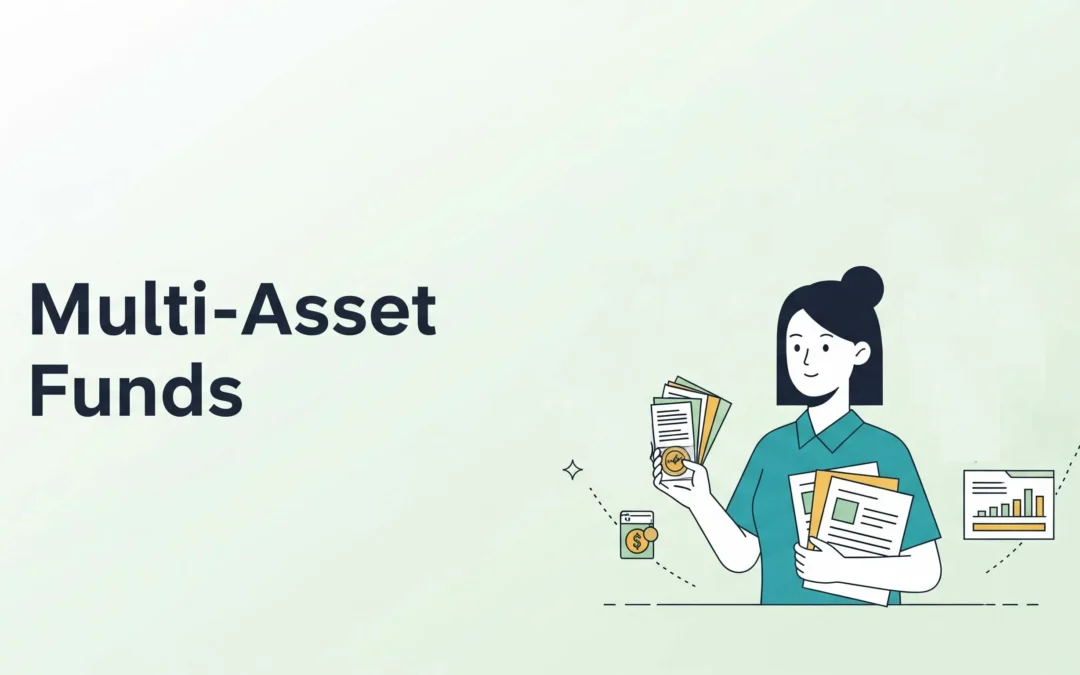The market is highly dynamic and volatile. Investors face different levels of risk depending on the investment option they choose. Multi-asset allocation funds give them an opportunity to diversify their investment to balance risk and return. But is it an all-weather solution for volatility? If yes, then how do they manage risk so well?
This article focuses on these questions that will give you clarity about the meaning of multi-asset allocation funds, along with the pros and cons. It will also help you know how these funds are a solution to high market volatility.
What Are Multi-Asset Allocation Funds?
Multi-asset allocation funds are diversified investments that integrate equity, debt, and alternative assets into a single portfolio, in contrast to single-asset funds (such as pure equity or debt). Usually, the allocation is changed in response to predefined ratios, fund manager tactics, or market trends.
Important Features:
- The investment is diversified across asset classes.
- It creates a risk-return balance by diversifying risks.
- Investors receive a consolidated, expertly managed product rather than making separate investments in debt funds, equity funds, and gold exchange-traded funds.
- It is high in liquidity as well as flexibility.
Pros of multi-asset funds:
- One-stop shop for diversification.
- Less volatility than funds that only invest in stocks.
- Ideal for Systematic Investment Plans, or SIPs.
Cons of multi-asset funds:
- During bull runs, it might perform worse than pure equity funds.
- Active management results in a higher expense ratio.
- Not tailored to particular financial objectives.
Example of Multi-Asset Allocation Funds:
The table below represents the examples of the same, along with showing the asset mix and 3-year CAGR for your better understanding:
| Fund Name | Asset Mix (Approx.) | 3-Year CAGR (approx.) | Risk Level |
| ICICI Prudential Multi‑Asset Fund (G) | Equity = 66%, Debt = 14%, Others = 20% | 22.7 % | Very High |
| HDFC Multi‑Asset Fund (Direct Growth) | Equity = 67%, Debt = 13%, Cash/Others = 20% | 18.05 % | Very High |
| Nippon India Multi‑Asset Allocation Fund | Equity = 57%, Debt = 13%, Gold/Other = 30% | 18.51 % | Very High |
Why Multi-Asset Funds Are Considered All-Weather Investments?
Investors are continuously looking for instruments that provide both growth and protection in a world where financial markets are becoming more and more unpredictable. Multi-asset funds are made to do fairly well in a variety of market cycles, like bullish, bearish, and everything in between. This is the reason they are frequently referred to as “all-weather investments.”
1. Asset Class Diversification
Multi-asset funds’ value diversification is their main advantage. Usually, they make investments across:
- Capital growth through equity
- Debt instruments for stability and income
- Gold or other commodities to protect against inflation
- International assets can occasionally be used for geographic diversification.
When one asset class performs poorly, the others can help mitigate the impact thanks to this diversified structure. For example, debt or gold components may provide stability or even yield positive returns when stocks are negatively impacted during a market crash.
2. Resilience in Different Market Conditions
| Market Condition | Fund Response |
| Bull Market | Equity allocation drives capital appreciation |
| Bear Market | Debt and gold components reduce losses |
| Inflationary Phase | Gold acts as a hedge |
| Interest Rate Hikes | The debt portion was adjusted to mitigate the impact |
| Global Uncertainty | Global diversification spreads risk |
3. Dynamic Allocation
Since the majority of multi-asset funds are actively managed, fund managers can change allocations in response to:
- Macroeconomic metrics
- Market patterns
- Metrics of valuation
- Perspective on risk
This flexibility aids in seizing opportunities while limiting exposure to undue risk.
Should You Consider Investing in Them?
Multi-asset allocation funds are best suitable for:
- New investors seeking passive diversification.
- Investors with a moderate to low-risk appetite, including retirees looking for stability and steady returns.
- Conservative to moderately aggressive investors seeking a balance between growth and stability, and who prefer consistent returns without frequent portfolio adjustments
- Investors with a long-term investment horizon aiming to navigate different market cycles with reduced volatility.
When Are They the Best Option?
- In volatile markets where no single asset class is clearly dominant.
Multi-asset funds diversify across asset classes to lower risk when market trends are uncertain. While gains in one asset class can often offset losses in another, this balance is not guaranteed in all market conditions. - When you want a portfolio that supports you through economic ups and downs.
These funds dynamically reallocate across debt, equity, and gold in response to economic cycles. This adaptability helps manage performance during both boom and recession phases, though returns may still vary depending on market severity. - To reduce the whole portfolio’s volatility.
They lessen abrupt fluctuations and stabilize returns by pooling different asset classes with low correlations. Multi-asset funds are well-suited for conservative to moderate investors seeking reduced risk and steadier growth, but the actual risk depends on the fund’s asset allocation.
Bottomline
The conclusion can be drawn that these funds are indeed a solution to the volatility in the market. They divide their investment and spread it across different asset classes, which helps to balance the risk. If one asset class is performing poorly due to certain factors, returns from other asset classes balance it. This helps in tackling the volatile market and generating returns throughout the market cycle.
However, it is always advised to conduct self-research to understand the funds more consciously and make an effective decision.
Written by: Tanya Kumar


